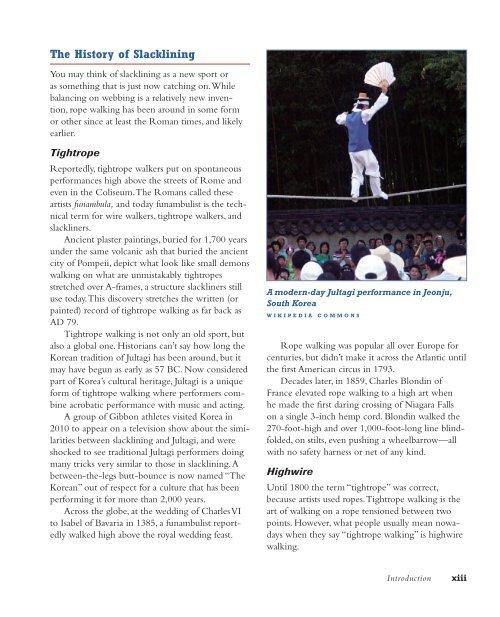How to Slackline! - Falcon Guides
How to Slackline! - Falcon Guides
How to Slackline! - Falcon Guides
You also want an ePaper? Increase the reach of your titles
YUMPU automatically turns print PDFs into web optimized ePapers that Google loves.
The His<strong>to</strong>ry of Slacklining<br />
You may think of slacklining as a new sport or<br />
as something that is just now catching on. While<br />
balancing on webbing is a relatively new invention,<br />
rope walking has been around in some form<br />
or other since at least the Roman times, and likely<br />
earlier.<br />
Tightrope<br />
Reportedly, tightrope walkers put on spontaneous<br />
performances high above the streets of Rome and<br />
even in the Coliseum. The Romans called these<br />
artists funambula, and <strong>to</strong>day funambulist is the technical<br />
term for wire walkers, tightrope walkers, and<br />
slackliners.<br />
Ancient plaster paintings, buried for 1,700 years<br />
under the same volcanic ash that buried the ancient<br />
city of Pompeii, depict what look like small demons<br />
walking on what are unmistakably tightropes<br />
stretched over A-frames, a structure slackliners still<br />
use <strong>to</strong>day. This discovery stretches the written (or<br />
painted) record of tightrope walking as far back as<br />
AD 79.<br />
Tightrope walking is not only an old sport, but<br />
also a global one. His<strong>to</strong>rians can’t say how long the<br />
Korean tradition of Jultagi has been around, but it<br />
may have begun as early as 57 BC. Now considered<br />
part of Korea’s cultural heritage, Jultagi is a unique<br />
form of tightrope walking where performers combine<br />
acrobatic performance with music and acting.<br />
A group of Gibbon athletes visited Korea in<br />
2010 <strong>to</strong> appear on a television show about the similarities<br />
between slacklining and Jultagi, and were<br />
shocked <strong>to</strong> see traditional Jultagi performers doing<br />
many tricks very similar <strong>to</strong> those in slacklining. A<br />
between-the-legs butt-bounce is now named “The<br />
Korean” out of respect for a culture that has been<br />
performing it for more than 2,000 years.<br />
Across the globe, at the wedding of Charles VI<br />
<strong>to</strong> Isabel of Bavaria in 1385, a funambulist reportedly<br />
walked high above the royal wedding feast.<br />
A modern-day Jultagi performance in Jeonju,<br />
South Korea<br />
w i k i p e d i a c o m m o n s<br />
Rope walking was popular all over Europe for<br />
centuries, but didn’t make it across the Atlantic until<br />
the first American circus in 1793.<br />
Decades later, in 1859, Charles Blondin of<br />
France elevated rope walking <strong>to</strong> a high art when<br />
he made the first daring crossing of Niagara Falls<br />
on a single 3-inch hemp cord. Blondin walked the<br />
270-foot-high and over 1,000-foot-long line blindfolded,<br />
on stilts, even pushing a wheelbarrow—all<br />
with no safety harness or net of any kind.<br />
Highwire<br />
Until 1800 the term “tightrope” was correct,<br />
because artists used ropes. Tightrope walking is the<br />
art of walking on a rope tensioned between two<br />
points. <strong>How</strong>ever, what people usually mean nowadays<br />
when they say “tightrope walking” is highwire<br />
walking.<br />
Introduction xiii








